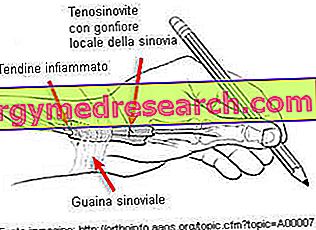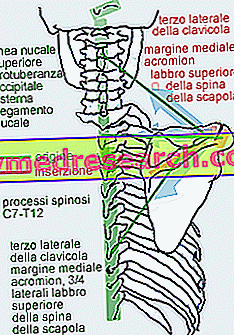Generality
De Quervain's stenosing tenosynovitis is an inflammatory process affecting the synovial sheath of the thumb tendons (long abductor and short extensor).

De Quervain syndrome can induce a series of functional limitations of the hand, especially if certain activities are performed. The determining cause of the condition is to be found in repeated micro-traumas, linked above all to professional activity (embroiderers, videoterminals, musicians ...).
The main symptom associated with De Quervain syndrome is the pain that occurs while taking thumb and thumb movements in the wrist. Sometimes a swelling can be associated, along the course of the tendons, which with the evolution of the disease, become inflamed going towards progressive wear (tendinosis) due to the narrowness of the canal.
Causes
The causes that determine the onset of De Quervain syndrome can be many:
- individual predisposition;
- repetitive tasks involving flexion-extension of the thumb (example: sewing, using the computer mouse or keyboard, playing an instrument, etc.);
- sudden functional overloads;
- rheumatic diseases.
Symptoms
To learn more: Symptoms De Quervain syndrome
The symptoms of De Quervain syndrome develop progressively and are:
- persistent pain on the outer face of the wrist and at the base of the thumb, accentuated by movements involving the area or while firmly grasping an object;
- swelling along the course of the tendons, compact and extremely painful to pressure;
- protruding painful, more or less accentuated, in correspondence of the thickening of the fibrous channel;
- if the therapy of the disease is neglected, the pain can spread from the thumb to the forearm.
Diagnosis
The diagnosis of De Quervain syndrome is basically clinical: the area that corresponds to the first carpus canal is swollen and extremely painful under pressure.

For a correct diagnosis the Finkelstein test is sufficient, in order to record the degree of pain felt by the patient: the maneuver consists in closing the hand in a fist, tightening the long fingers around the thumb and flexing the wrist towards the little finger. In fact, in the subject suffering from De Quervain syndrome, the thumb movements are difficult due to the intense pain, which is sharpened when the wrist is tilted. Ultrasound enables us to accurately highlight the inflammatory changes in tendons and their relationships with the walls of the synovial sheath.
Treatment
In the early stages, conservative treatment, such as functional rest or taking anti-inflammatory drugs, can resolve the symptoms and is aimed at reducing inflammation. Applying an ice bag to the radium styloid process can reduce pain. In the most important cases, corticosteroids can be administered by infiltration.
When symptoms are severe and do not improve with conventional therapies, surgical treatment ( puleggiotomy ) is required. The operation consists in opening the sheath, so as to favor the correct sliding of the tendons. The intervention is decisive and the positive effects are immediate, from the functional point of view (the optimal recovery is obtained already after three or four days from the operation). The prognosis is therefore excellent.
If De Quervain syndrome is neglected and not adequately treated, tenosynovitis may develop into rhizoarthritis (osteoarthritis of the base of the thumb).



